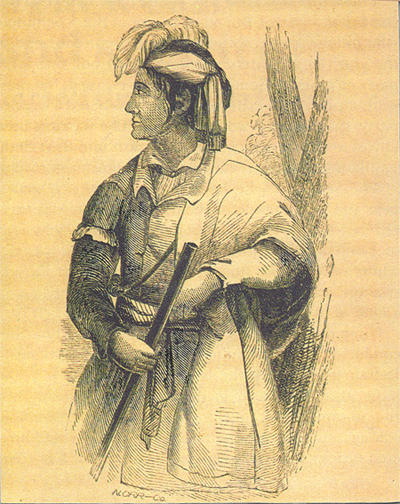Wild Cat, a cat with the heart of a lion
By R Mendocino
Nobody knows exactly where Black Cat first saw the light of day or where his remains were laid to rest. Nobody knows for sure if he was really a son of King Philip (Ee-mat-la in native language), the last grand chief of the Seminole. All we know is his harmonious and full of courage heart earned him the right to be his successor and leader of the Seminoles and the Black Seminoles. He led his followers to the other side of the river, not exactly to the Promised Land but to a land where they would be truly free.
After the United States acquired Florida in 1821, the settlers invaded more and more of their traditional lands. The Seminoles supported the escape of slaves from Georgia to join the Seminoles’ black friends, who had lived in Florida for about a century. They got to be known as the Black Seminoles.
Wild Cat was still a teenager when he joined his father in the second war between the US Army and the Seminole. He gained prominence as a war leader with a band of Seminoles and Black Seminoles until his father was captured and imprisoned in Fort Marion in 1837. It was then that Wild Cat’s harmonious heart prompted him to seek peace for his people and their neighboring black friends. He was wearing a ceremonial peace headdress when he appeared before American Colonel Thomas S. Jesup for the pre-arranged peace talks and negotiations. Jesup, however, was waiting for the arrival of the Seminoles to get them arrested; they were also sent to Fort Marion. Wild Cat planned an escape with nineteen other Seminoles. History tells they all fasted for six days to be able to slide through the bars of their jail cells.
Wild Cat emerged as the leading commander of the war fighting with his uncle Micanopy or Alligator and Arpeika against Colonel Zachary Taylor in Battle of Lake Okeechobee on December 25, 1837. The bloody battle was not good for any side and the Seminoles retreated to the Everglades while the US Army called for reinforcement.
King Philip died while in 1839 while being transported to Indian Territory in present day Oklahoma. After his father’s death, Wild Cat agreed once again to talk to American authorities and he met with Lieutenant William T. Sherman for peace negotiations at the Indian River post of Fort Pierce.
Wild Cat accepted a piece of land in the Indian Territory of Oklahoma for the remaining of his followers, about 200 Seminoles and Black Seminoles. After what he considered a defeat, Wild Cat pronounced these words:
"I was in hopes I would be killed in battle, but a bullet never reached me."
In the Indian Territory, the tribe suffered a series of floods and raids by the neighboring Creeks, who captured free Blacks and Seminoles to sell them as slaves in the southern states. Wild Cat and his uncle Micanopy traveled to Washington, D.C. with a Seminole delegation in 1843 seeking assistance but they failed to gain any financial aid. Disappointed, Wild Cat abandoned the reservation with a group of about one hundred members composed of Seminoles, free Blacks and former slaves. In Texas, they were joined by about a thousand Kickapoo Indians. The group, led by Wild Cat, crossed the Rio Grande into Mexico where they were given some land and autonomy near Muzquiz as well as hunting privileges in exchange for protection to the city from Apache and Comanche raiders. In recognition for his bravery and service, Wild Cat was given the commission of Colonel in the Mexican army.
The Seminoles and the Blacks, still live in their land on the west side of the Sabinas River at El Nacimiento, while the Kickapoo live in La Rancheria on the East side. The Mexican Kickapoo were recognized as US Citizens and can travel to their lands in Texas and Oklahoma crossing the border freely. The descendants of the Seminoles and the Black Seminoles, however, are not allowed to return to the United States.
Wild Cat died of smallpox in 1857. The US government sent a delegation to Mexico to retrieve his remains but his people and the Kickapoo, honoring his last wish, have kept Wild Cat’s tomb place a secret. He was succeeded by his son Gato Chiquito or Young Cat.
And it was there, in a strange land, where Indians from the Everglades, Indians from the Northern Wetlands, former slaves and free Blacks, all lead by Wild Cat finally found the freedom he always dreamed of.
"I speak for myself, for I am free.
Each of the others also speak for themselves.
We are a choir of free voices."
Wild Cat (Seminole)
c. 1807/1810–1857
Wild Cat or Cowacoochee from the Creek Kowakkuce "bobcat, wildcat." Leading Seminole chieftain
during the later stages of the Second Seminole War. Son of King Philip or Ee-mat-la and nephew of Micanopy.

